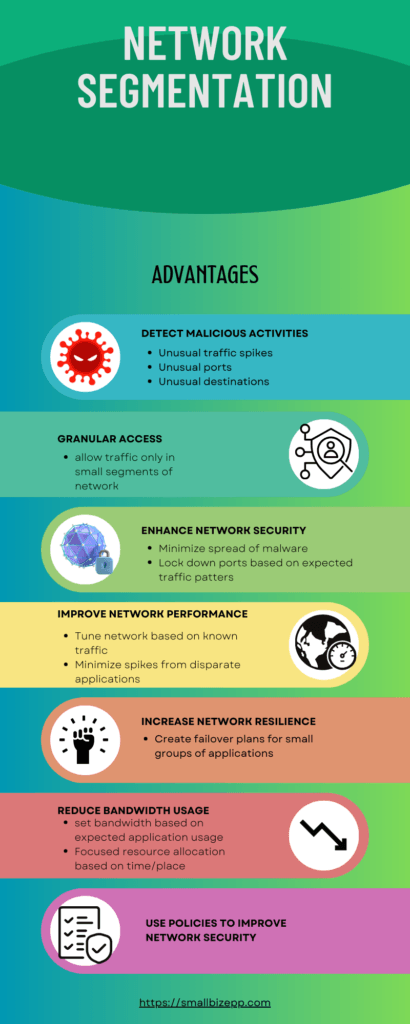What is Network Segmentation?
Network segmentation is the practice of dividing a computer network into smaller parts in order to improve security and performance. By implementing advanced network segmentation strategies and best practices, organizations can improve security. Network segmentation can limit access and visibility to sensitive and critical areas of their network. Additionally, network segmentation allows for the deviation of traffic from certain areas of the network. This will improve performance for core network applications. Create the right segmentation strategy for the enterprise network. By doing so, IT professionals can ensure secure and efficient access to all resources, helping the organization reach its goals.
Unlock the full potential of advanced network segmentation strategies to bolster your network’s security. Discover how meticulous policy creation, precise resource identification, and strategic use of allowlists can transform your network’s defense. Network segmentation, a critical practice in modern cybersecurity. It involves dividing a network into distinct functional domains to restrict inter-domain communications, thereby fortifying network security.

Benefits of Network Segmentation
Network segmentation is an effective strategy to protect the enterprise network and provide better security. With an effective segmentation strategy, security teams can protect the network from cyber threats, unauthorized access and malicious actors. By logically segmenting the network, Companies can achieve granular control over the flows across the network.
This will enable them to:
- detect malicious activities
- create granular access control layers
- enhance the overall security of the network
- improve network performance
- increase the resilience of the network in the event of an attack.
Implementing Network Segmentation
Network segmentation is a key part of network security and one of the best practices for effective networks. It involves dividing part of the enterprise network from the rest of the network. Doing so, traffic can be more easily monitored and managed. By implementing network segmentation, security policies can be applied to different parts of the network. This also can help control the flow of network traffic.
Network segmentation helps network administrators, by providing more control and visibility to the data traffic within the network.
This will help to:
- improve network performance
- reduce bandwidth usage
- improve security by managing network segments with specific security policies.
Network segmentation is an effective way to divide up computer networks. It provides administrators with an efficient way to manage and monitor network traffic.
Network Segmentation Best Practices
It is important to develop a good network segmentation strategy for better data security and performance. Network administrators can use different segmentation policies to break down the network into multiple, smaller segments, creating an increased level of security for the organization as well as alleviate any possible network congestion. Network segmentation involves dividing the network into logical segments, as well as the physical separation of the different networks within the network perimeter. This creates different network architecture to provide a more secure security posture.
Additionally, having a network segmentation strategy in place will provide the benefits of preventive and detective controls to ensure the integrity of the data. Network administrators can use this to segment the network into smaller, manageable portions with well-defined firewall policies in place to monitor traffic flow. By implementing a proper network segmentation best practices, organizations can significantly improve their security posture while also minimizing disruption of their network by leveraging security and performance gains.
Segmentation Strategy for the Enterprise Network
An effective segmentation strategy for the enterprise network is imperative to secure the network and enhance security across the network. Physical segmentation is a highly important security measure for separating data and devices while dividing a computer network into segments. This helps reducing the attack surface and makes it easier to detect anomalies; leading to fewer successful attacks and generally improving the overall security posture of the network.
Network segmentation security can be evaluated against Payment Card Industry Data Security Standard (PCI-DSS) and other security protocols of the organization. Network segmentation creates a system of segmented network layers that help protect confidential resources, as segmenting helps reducing the attack surface and breaking the network into smaller pieces; thus reducing risk and providing an extra layer of security. It also helps with identifying changes across the overall network which would be harder to spot within a flat network. Moreover, network segmentation reduces the number of endpoints to be monitored and secure, improving network performance. By segmenting a network, organizations can easily focus their efforts on the highest value areas and provide the right security measures to protect them.
Improve Security with Network Segmentation
Network segmentation is an architectural method for improving network security by dividing the entire network into separate security zones. This enables resources within each zone to be effectively segmented from resources in other zones. Firewall segmentation and cloud security can also be used in segmented networks to limit access to certain areas of the network. By using network segmentation, organizations can control access to different network resources, reduce security risks by limiting access to areas with sensitive data, and control communications between different network components. Network segmentation also enhances the overall network performance by allowing administrators to better structure the network structure and boundaries while isolating certain critical resources from the rest of the network.
Network segmentation solutions may involve software-defined networking (SDN) technologies to better segment the network infrastructure. This allows for improved visibility into the network, providing admins with better control over what nodes, services, and other elements of the network can communicate with each other. By setting up segmented networks, a company can know precisely who can access which network resources and when, making it easier to spot suspicious activity and take immediate action. To learn more about network segmentation, visit the Network Segmentation Resource Guide to get more information and find solutions to improve your network’s security.
The Power of Microsegmentation in Dynamic Environments
Microsegmentation offers a more detailed approach. It divides the network into ultra-specific segments, down to individual workloads or applications. This granularity allows for custom security policies per segment, enabling a ‘zero trust’ model. Here, no entity is trusted by default, significantly limiting the impact of breaches.

Microsegmentation excels in dynamic environments like cloud infrastructures. It leverages software-defined networking (SDN) for agile security updates, ideal for rapidly changing networks. This method enhances visibility, helping administrators detect and respond to threats more effectively.
Dividing a Computer Network into Segments
Network segmentation is the practice of dividing a computer network into smaller subnetworks, also known as network segments or subnets. This process creates distinct network security boundaries, enhancing the protection of sensitive information from unauthorized access. Additionally, network segmentation optimizes network performance by efficiently directing traffic flows and isolating specific network activities.
Physical And Logical Segmentation: Dual Approaches to a Common Goal
In the realm of network segmentation, two primary approaches are employed: physical and logical segmentation. Physical segmentation involves using hardware devices like routers and switches to create tangible boundaries within the network. This method is particularly effective in controlling the physical access to different network areas and is often used in environments where high-level security is paramount. On the other hand, logical segmentation is achieved through software configurations, such as virtual LANs (VLANs) and firewall policies. This approach offers greater flexibility and scalability, allowing for dynamic adjustments and policy enforcement without the need for additional physical infrastructure. Logical segmentation is ideal for rapidly changing network environments and can be more cost-effective than physical segmentation.
Both physical and logical segmentation play critical roles in fortifying network security. They enable more targeted security strategies, such as monitoring for malicious traffic and isolating different levels of communication within the network. With physical segmentation, the use of multiple firewalls can further limit the lateral movement of malware within the network perimeter. Logical segmentation, meanwhile, allows for the creation of virtual barriers that can be quickly adapted to emerging security needs.
Both forms of segmentation reduce the internal pathways malicious actors can exploit, increasing the difficulty for them to locate vulnerabilities and compromise the system. By reducing broadcast traffic and limiting the systems needing maintenance, network segmentation not only improves security but also enhances network performance and reduces maintenance costs. Proper implementation of both physical and logical segmentation is necessary to maximize the benefits of a comprehensive segmentation strategy, effectively reducing the attack surface and bolstering overall network security.
Network Performance and Network Segmentation
Proper network segmentation is essential to any enterprise’s security and performance. Network segmentation involves the division of a computer network into smaller units, optimally designed to serve different functions. This approach to network segmentation minimizes the risk of security issues by controlling access to each segment of the network and creating a secure network environment.
Network segmentation provides an organization with the flexibility to apply customized security policies to each network segment, allowing security administrators to create a tailored security approach using segmentation. Segmentation ensures the organization’s overall security is maintained by defining user access to resources. Additionally, using segmentation helps to establish best practices for effective security by defining rules and processes for implementing segmentation practices.
What is Network Segmentation?
Network segmentation is the process of dividing a computer network into smaller sub-networks, or segments, in order to improve security, performance, and manageability.
What are the Benefits of Network Segmentation?
Network segmentation can provide a number of benefits, including improved performance, enhanced security, simplified management, and increased scalability.
How Can I Implement Network Segmentation?
Network segmentation is typically implemented using a combination of hardware-based access control lists (ACLs) and software-based virtual LANs (VLANs).
What are the Best Practices for Network Segmentation?
The best practices for network segmentation include proper segmentation of networks based on needs, prioritization of traffic based on criticality, and monitoring of segmentation rules to ensure compliance.
What is the Segmentation Strategy for the Enterprise Network?
The segmentation strategy for the enterprise network should be based on the organization’s security needs, and should include segmentation of networks by need, location, and user type.
How Does Network Segmentation Improve Security?
By dividing a computer network into smaller sub-networks, network segmentation can help to limit the spread of malicious code, reduce the risk of unauthorized access, and protect sensitive data from attack.
How Do You Divide a Computer Network into Segments?
Computer networks can be divided into segments using a combination of hardware-based access control lists (ACLs) and software-based virtual LANs (VLANs).
How Can Network Segmentation Improve Performance?
Network segmentation can improve performance by isolating traffic from different parts of the network, allowing for more efficient routing of data, and freeing up bandwidth for critical applications.

Experienced cybersecurity analyst, software engineer, patent attorney, worked with Linux, Windows, AWS, lots of security tools. Hope to help people do the right things and do the things right!


